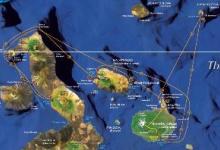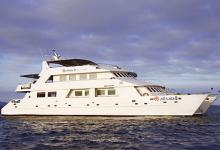Recently Viewed Cruises
- Athala II, Galapagos (with Genevosa) ex Baltra ReturnAdd to favourites
- Favalosa, Brazil ex Santos RoundtripAdd to favourites
- G5, Galapagos Voyage ex Quito ReturnAdd to favourites
- Serena, Argentina Brasil Uruguay ex Buenos Aires ReturnAdd to favourites
- Santa Cruz, Equador & Galapagos ex Quito ReturnAdd to favourites
- Catch up on Cruising: Latest cruise news in bite size
- Oceania puts the flags out for Insignia
- Luxury cruising booms
- Catch up on Cruising: Latest cruise news in bite size
- Royal Caribbean International raises the bar
- Frequently Asked Questions
-
Athala II, Galapagos (with Genevosa) ex Baltra Return
Nights 7 Ship Athala II Star Rating Specialty Departs Baltra, Galapagos Is Sailing 2013: 23 Feb ,9 Mar ,23 Mar ,6 Apr ,20 Apr ,4 May ,18 May ,1 Jun ,15 Jun ,29 Jun ,13 Jul ,27 Jul ,10 Aug ,24 Aug ,7 Sep ,21 Sep ,2 Nov ,16 Nov ,30 Nov ,14 Dec ,28 Dec Ports of Call Baltra, Isla Santiago, Bartolome Island, Isla Isabela, Punta Espinoza, Isabela Island (Punta Vicente Roca), Puerto Egas (Santiago), Puerto Ayora, Genovesa, North Seymour Please enquire about this cruise for pricing.
7 Night Cruise sailing from Baltra roundtrip aboard Athala II.
For those looking for a Galapagos adventure cruise in style, the 16-passenger Athala II provides a cozy small yacht atmosphere, comfortable accommodations, personalized service, a dedicated cruise director, and more; in order to offer the best service to our passengers and be aware of their needs.
This Motor Catamaran was specifically designed and built to cruise the Islands providing comfort and excellent stability for those looking for a Galapagos adventure cruise in style.
Detailed Itinerary:
SATURDAY- ARRIVAL IN GALAPAGOS
Check-in to your cabin
Introductory briefing & safety drill
Lunch
Panga ride to Mosquera Island
18:00 Back on board
19:30 Briefing on Sunday's program
20:00 Welcome cocktail
20:15 Dinner
Mosquera Islet: This tiny islet is actually home to a huge population of sea lions and is also home to many shorebirds. While at Mosquera, keep your eyes peeled as
there are occasional reports of dolphins and orcas. Difficulty level: Easy
SUNDAY - SANTIAGO & BARTOLOME ISLANDS
06:30 Wake up call
06:45 Breakfast
07:30 Dry landing at Sullivan Bay for hike and snorkel
10:30 Back on board
12:00 Lunch
14:00 Wet landing on Bartolome Island for shallow or deep water snorkeling
16:30 Back on board
17:00 Dry landing on Bartolome for hike or panga ride
18:00 Back on board
19:30 Briefing on Monday's program
20:00 Dinner
Sullivan Bay is known for its spectacular volcanic formations, relatively young pahoehoe lava flows, and unique geological scenery. Sullivan's relatively recent volcanic activity, few plants have been able to take
root here, much less be successful, so pay particular interest to the low-lying pioneer plant known locally as "mollugo" as well as the lava cactus.
Bartolome is a small island that has two visitor sites. At the first site, you can snorkel around Pinnacle Rock, where
penguins are usually seen. Then, it's back on board for a quick change of clothes followed by a short dinghy ride to a dry landing for a climb to the highest point on the island. On the way up, you will encounter different volcanic formations, including spatter and tuff cones, lava flow and lava tubes. From the summit you will have a wonderful view of Sullivan Bay. For those not interested in the hike, there is the option of a panga ride. Usual fauna
and flora also includes sea lions, pioneer plants, reef sharks, rays and colorful reef fish.
Difficulty Level: Moderate. Walk up 375 low-grade stairs to top of volcano at a slow to moderate pace.
MONDAY - ISABELA ISLAND
06:45 Wake up call
07:00 Breakfast
08:00 Wet landing at Urbina Bay for excursion
11:00 Back on board
12:00 Lunch
15:00 Dry landing at Tagus Cove for power hike, panga ride or kayaking
17:00 Back on board
19:30 Briefing on Tuesday's program
20:00 Dinner
Urbina Bay is located in Western Isabela, at the foot of Alcedo volcano. After landing on a beautiful black-sand beach, you may be able to observe sea turtle nesting sites.
This area is also known for penguin and flightless cormorant sightings and is one of the best places to see Darwin's finches as well as large land iguanas. Be on the
lookout for wild Galapagos tortoises which like to feed within the site's dense vegetation.
Difficulty level: Moderate
Tagus Cove was historically used as an anchoring place for pirates, buccaneers and whalers. Here you will see the
names of hundreds of ships painted on the high ridges (a practice now forbidden). On the hike, the trail goes
through an area of vegetation and the volcanic landscape of Darwin volcano. At the top of the trail, you will enjoy an
incredible view of the whole cove and Darwin Lake.
The brisk "power-hike" is followed by kayaking or a panga ride, where you will have the opportunity to see a large
number of blue-footed boobies perched on the ledges of the cliffs, as well as marine iguanas, penguins, brown pelicans, brown noddy terns and swallow-tailed gulls.
While exploring the channel between Fernandina and Isabela Islands, we sometimes encounter dolphins and whales. Difficulty level: Easy to Difficult
(panga ride is easy; hike up to lake can be strenuous for some)
TUESDAY - FERNANDINA & ISABELA ISLANDS
06:30 Wake up call
06:45 Breakfast
07:30 Dry landing at Punta Espinoza, Fernandina Island
10:30 Snorkeling at Punta Espinoza
11:30 Back on board
12:00 Lunch
15:30 Panga ride along Punta Vicente Roca or deep water snorkeling
17:30 Back on board
19:30 Briefing on Wednesday's program
20:00 Dinner
Fernandina Island is one of the most pristine ecosystems in the entire world and also one of the most dynamic.
La Cumbre Volcano last erupted in April 2009, and also dominates the landscape, with lava fields stretching towards the ocean from its base. Punta Espinoza is a narrow piece of land where some of the most unique Galapagos species can be seen, including the flightless cormorant, Galapagos snakes, marine iguanas, penguins and the Galapagos
hawk.
Difficulty level: Moderate
Punta Vicente Roca is a wonderful snorkeling site, where you can usually see turtles as well as all kinds of fish. For those who do not snorkel, a panga ride will give
you the opportunity to study some of the Galapagos' spectacular geological rock formations. Nazca boobies, pelicans, swallow-tailed gulls, marine iguanas, flightless cormorants and penguins are often seen in the area. Difficulty level: Easy to moderate
WEDNESDAY - SANTIAGO ISLAND
06:30 Wake up call
06:45 Breakfast
07:30 Wet landing at Puerto Egas, Santiago Island
09:00 Swimming and snorkeling from the beach
11:00 Back on board
12:00 Lunch
15:00 Wet landing at Espumilla Beach for hike, panga ride, swimming or snorkeling
18:00 Back on board
19:30 Briefing on Thursday's program
20:00 Dinner
Puerto Egas (James Bay) is located on the northwest side of Santiago Island. The landing is on a black beach with eroded
rock formations in the background. The trail crosses the dry interior, where the remains of a salt mining enterprise can still be seen, and then continues along the coast. Tidal pools are home to a variety of invertebrate organisms, including sea urchins, octopus and starfish. You will also see marine iguanas, finches, oyster catchers and possibly the Galapagos Hawk. The trail leads to the Fur Sea Lion Grottos, one of the only places in the islands where these unique animals can be seen. After the walk, you will have time to swim or snorkel off the beach, where you will
see sea lions, fish and maybe some turtles, rays and maybe some reef sharks.
Difficulty level: Easy to Moderate.
The Espumilla Beach visitor site is on the northern coast of Santiago Island in James Bay. The main attractions here
are a Palo Santo forest, beach and the landscape. The Palo Santo forest at Espumilla has some of the tallest specimens of the species in the entire archipelago. Also look out for the Galapagos Hawk as well as Darwin's finches. The beach is an important site for nesting marine turtles.
Difficulty level: Easy
THURSDAY - SANTA CRUZ ISLAND
06:45 Wake up call
07:00 Breakfast
08:00 Dry landing at Puerto Ayora on Santa Cruz Island to visit the Charles Darwin
Research Station, afterward bus ride to the highlands of Santa Cruz to see
wild giant tortoises
13:00 Back on board & lunch
15:30 Afternoon at leisure
18:00 Back on board
19:30 Briefing on Friday's program
20:00 Dinner
On your visit to the Charles Darwin Research Station you will gain insight into the great efforts being made by
scientists, guides, rangers and park managers to preserve this UNESCO World Heritage Site. You will see the famous
Galapagos tortoises that are the islands'namesake.
After the visit we drive to the green highlands of Santa Cruz, where you will visit a tortoise reserve to search for giant tortoises in their natural surroundings.
Difficulty level: Easy to moderate.
FRIDAY - GENOVESA ISLAND
06:30 Wake up call
06:45 Breakfast
07:30 Dry landing at El Barranco
10:00 Snorkeling, kayaking or panga ride
11:45 Back on board & lunch
14:30 Wet landing and excursion at Darwin Bay
16:30 Beach time, snorkeling or kayaking
19:15 Departure briefing
19:45 Farewell cocktail
20:00 Dinner
21:00 Please settle your bills
Genovesa, or Tower Island, is the northernmost island that is allowed to be visited by naturalist (non-diving)cruises. This island is extremely remote and home to literally millions of birds belonging to many different species
including the red footed booby as well as frigates, swallow-tailed gulls and even endemic owls! There are two sites
on Genovesa that are visited by the M.C. Athala.
El Barranco, also known as Prince Phillip's Steps, is a steep path with stairs carved into the rock which leads to a plateau full of bird life amongst a Palo Santo forest.
You will see Nazca boobies, Galapagos doves, mockingbirds and petrels. With some luck, you may spot a short-eared lava owl.
Difficulty level: Moderate.
Darwin Bay's soft, coralline white sand is only the beginning of a spectacular excursion. A trail from the beach takes you into lush mangroves where red footed boobies nest. Other locals include sea lions, swallow-tail gulls, frigates and more. Snorkeling is a must here as
sharks, colorful reef fish, rays and sea turtles are common.
Difficulty level: Easy to moderate.
SATURDAY - NORTH SEYMOUR ISLAND & DEPARTURE
05:45 Optional wake up call by phone
06:00 Short hike at North Seymour Island
07:00 Back on board for breakfast. At the same time, the crew will take the
luggage to check it at the airport.
07:30 Breakfast
08:15 Disembark
North Seymour may very well be the perfect way to say goodbye to the Galapagos Islands. Although the island is characterized by arid vegetation, fauna abounds and
you will soon find yourself surrounded by frigates, blue footed boobies, land iguanas and more.
Difficulty level: Moderate.
You will then be transferred to Baltra Airport.







